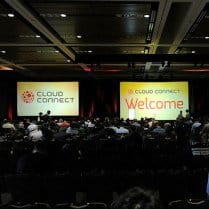Blog
7 Things We Learned at Cloud Connect | Gaining Altitude in the Cloud

Originally posted on Leverhawk
It was an interesting week last week at Cloud Connect Silicon Valley. In addition to the keynotes and track sessions, we also saw the release of the summary results of the latest joint Cloud Connect / Everest Group survey on enterprise cloud adoption. Here are the seven things we took away from the conference, the survey results, and the discussions we had:
- The power shift from IT to business is real – one of the key findings from the adoption survey was that outside of dev test environments, disaster recovery (DR) and email / collaboration, business stakeholders are the primary drivers of enterprise cloud adoption. Anecdotal conversations with practitioners and vendors alike reinforced this idea that the cloud is permanently changing buying behaviors in the enterprise. This is bad news for many of the legacy enterprise IT players, who struggle with transitioning from a CIO-centric sales model to one focused on emerging business buyers.
- OpenStack is on a roll – one of the common themes in both the sessions and side conversations is that OpenStack appears to be gaining steam not just with the Foundation members but with enterprises as well. In fact one leading financial services player we met there has the target of moving half of their production workloads to OpenStack by the end of the year. We heard countless more examples of deployments that were in fact more than just pilots, and indications that OpenStack is starting to gain serious momentum.
- Cloudwashing is contagious – many legacy enterprise IT vendors have a lot to lose as their customer base migrates to the cloud. It’s probably not surprising that many of them are happy to have their customers mistakenly believe that virtualized environments = private clouds. As a result we have the unfortunate phenomena of organizations claiming and believing that they’re migrating to private cloud models, when in fact they’re really not.
- Cloud infrastructure can create competitive advantage – while applications, analytics and data are commonly seen as the source of IT-enabled competitive differentiation, we heard about how some enterprises are actually seeking cloud infrastructure as potential sources of business advantage. We heard from one other major financial services firm that the speed and agility benefits being provided by the combination of cloud and open source was in fact creating competitive business advantage in the marketplace.
- Shadow IT doesn’t always mean happy customers – a growing trend that we heard a bit about was the “lose / lose” dynamic that was being created in some organizations by shadow IT. The scenario goes like this: business buyer asks corporate IT for on-demand infrastructure services, with requirements that are perhaps a bit unrealistic. Unhappy with the response they hear, business buyer instead goes to a public cloud IaaS provider, but quickly realize requirements aren’t met there either, but for different reasons. The result is one unhappy customer and two unhappy service providers. While this is the exception not the norm today with shadow IT, it is a trend worth watching. Note to business buyers: with freedom comes responsibility, certainly at least to understand your real requirements.
- Compliance isn’t stopping adoption – conventional wisdom suggests that highly regulated verticals will be adoption laggards due to security and compliance concerns. A series of sessions with IT executives at Novartis, American Express and Fidelity proves that’s not the case. While in the most case they’re focus is on private cloud models, the motivation is still around business drivers – providing faster, cheaper and more effective applications and capabilities. The initiatives they’re driving are global in nature, and far from the ubiquitous proof-of-concepts that everyone seemed to be discussing last year.
- The tipping point is near – if it’s not here already, we’re close to the point where cloud becomes accepted as the primary IT delivery model going forward. The conference survey showed that the majority of enterprises now expect migration to some type of cloud model (public, private hybrid or other) across all major workload types. This isn’t to say that everything will migrate tomorrow, or that it will make sense to migrate everything to cloud models (it won’t), but it does say that market conversation around whether cloud makes sense for the enterprise may be close to over.
Interested in reading more about how cloud is driving enterprise transformation? Check out our recent post on how JP Morgan Chase is using PaaS to transform internal application development. Also read our guide on understanding the Great Tech War being fought across cloud, mobile, digital content and big data.
Photo Credit: Cloud Connect